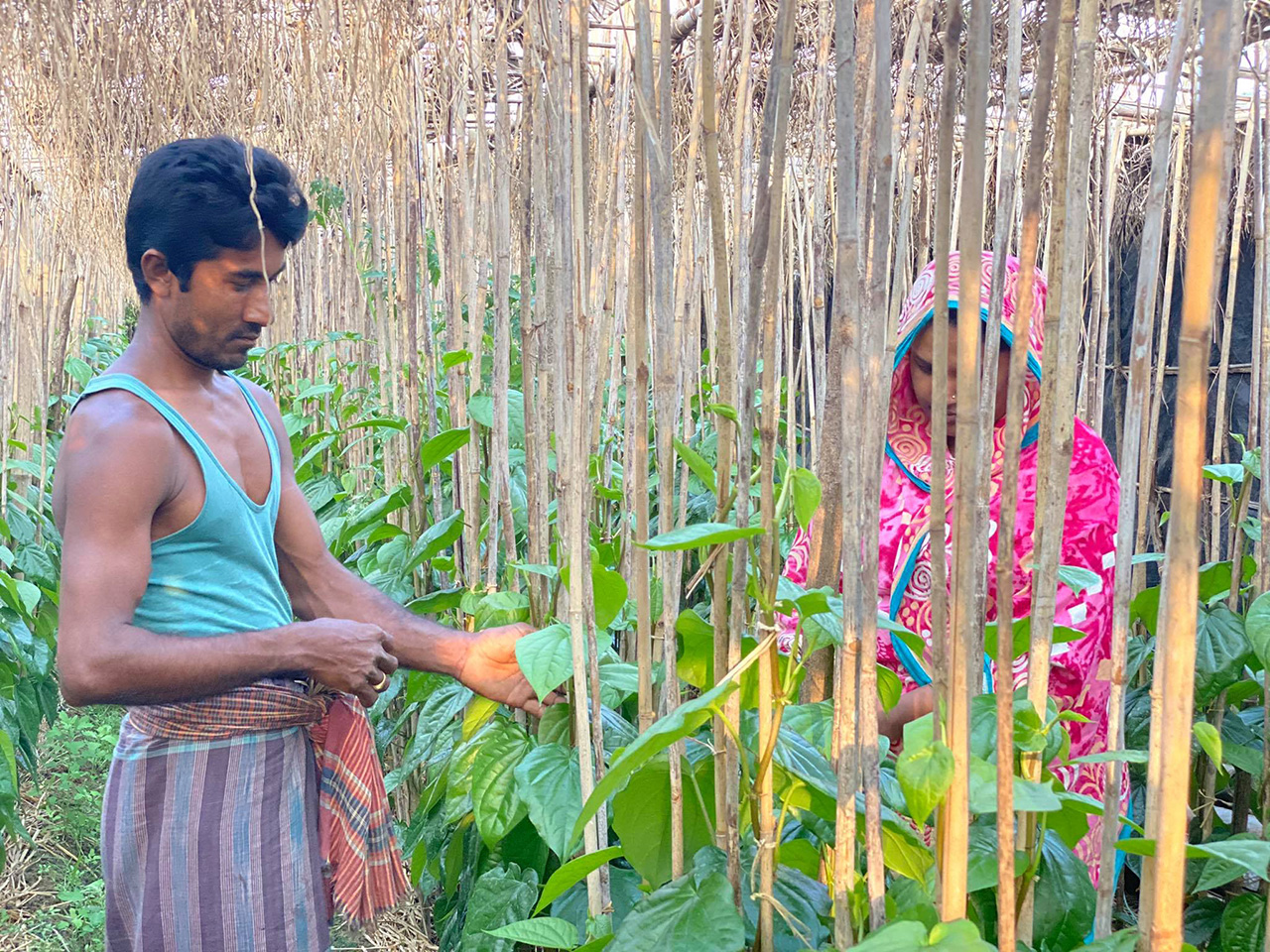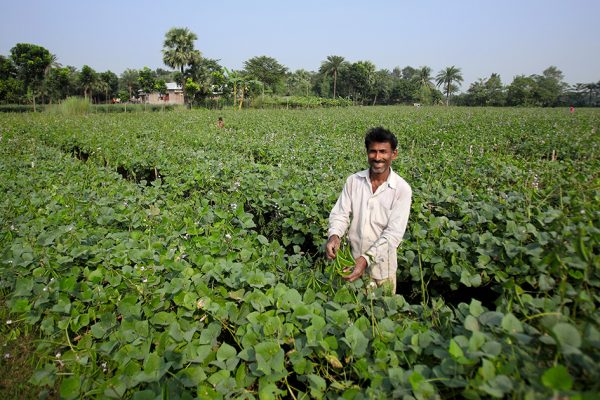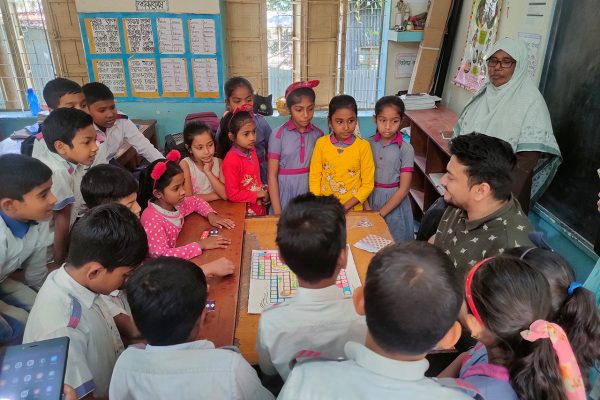Dry fish, betel leaf and business: Three women challenging poverty in Bangladesh
Reading Time: 4 minutes
Cox’s Bazar, popular as the longest uninterrupted sea beach in the world, is also now globally known as the home of the largest refugee camp. The sudden influx of refugees added multiple challenges to people living in the host community, including a fall in wages and price hike of essential commodities.
Cox’s Bazar’s geographic location, social and religious outlook, and refugee surplus demand targeted development interventions to lessen the economic vulnerability of the host communities residing there.
The necessity of supporting the host community for building better livelihoods is as acute as addressing the needs of the refugees. A study by the United Nations Development Programme (UNDP) suggests that host communities have been facing multiple challenges including price hikes, fall in daily wages for labour work, service shortages and environmental degradation since the refugee influx. To improve the overall poverty rate of Cox’s Bazar, targeted interventions for both the refugees and host community are required.
BRAC’s Ultra-Poor Graduation (UPG) programme has been working with the host community since 2018, with context-specific interventions to strengthen the socio-economic capacity of the host community members, alongside the organisation’s humanitarian response work in the refugee camps. Up until 2020, the UPG programme reached more than 8,000 participants in the host community and 95% of them have graduated out of poverty.
From defying stereotypes to identifying new earning opportunities, UPG participants from the host community of Cox’s Bazar are improving their lives by leaps and bounds. Here is how they are breaking barriers:
1. Leveraging local resources

Cox’s Bazar is the hub for dried fish in Bangladesh, a popular local dish with a strong market demand.
Rajiya Akhter is a dry fish seller living in Cox’s Bazar. With the sudden demise of her husband, she took the responsibility of running her entire family. When she first decided to join BRAC’s UPG programme, her neighbours discouraged her from working outside alone. Although hesitant initially, Rajiya realised that she needed to take control of her life.
She started to buy fish from local fishermen, processed them to make dry fish. She built a wooden platform surrounded with nets to protect the fish from bugs with the guidance from a BRAC staff. She bought a goat, and applied home-gardening techniques to cultivate different vegetables, to expand her earnings further.
By leveraging available resources and support from local service providers, Rajiya tapped into a huge market. She is now an independent single-mother who does not bow to societal pressure.
Read more: Can empathy end poverty?
2. More women at the decision-making table

A common narrative across the world is women are responsible for the home and family, while men are the bread-earners. This same societal belief makes families prioritise boys over girls in education, nutrition, health-care and other basic needs. Cox’s Bazar has 91% of the labour force being dominated by males.
Things however are changing with women like Noorjahan, who are using self-employment opportunities to break stereotypes.
Noorjahan is a betel leaf producer. In just four months, she sold BDT 60,000 (USD 707) worth of betel leaves. She gathered assets with the amount and leased a piece of land for cultivation, and through the programme’s asset transfer component, bought the inputs needed.
Her business partner is her husband Nur Kamal who daily works with her in their 20 decimal (8,712 square feet) leased land. Noorjahan used to be a homemaker, depending on her husband’s earning from his job as a day labourer.
Things changed when Noorjahan started her own betel leaf enterprise. She received interest free loans and hands-on coaching through the Ultra-Poor Graduation programme, started her betel leaf production and started to earn good money. To support her business expansion, her husband left his work and joined her.
They have bigger dreams now, and are planning to harvest rice during peak season and buying a cow to further diversify their earnings.
When her husband was asked if her working in the field is causing any issues in managing family responsibilities, he smilingly replied, “There are no such issues. I am glad to be supporting her in the great work she does both in the field and at home.”
This story of Noorjahan represents hundreds of UPG participants. An impact evaluation study done in 2020 by BRAC Institute of Governance and Development suggests that UPG’s interventions in Cox’s Bazar have largely contributed to women’s empowerment in the working areas. More women are actively participating in the labour force, decision-making and asset accumulation.
Read more: Celebrating the stories of 2 million women
3. Precise targeting

Taiyaba Khatun is a 60-year-old businesswoman. She runs a grocery shop in the village of Shah Porir Island in Cox’s Bazar. The government’s social safety net was her sole means of income, after her husband died. To support herself and her son who works as a day labourer, she joined the Ultra-Poor Graduation programme as a participant, and received grant money and coaching on running a small business. She always dreaded taking loans with interest due to her age, but she was determined to improve her livelihood, and this grant seemed like a new opportunity.
The UPG programme in Cox’s Bazar targets people living in ultra-poverty in two categories based on socio-economic criterias. People like Taiyaba fall under the group where family members are mainly dependent on the participants’ earnings and have assets of less than 15 decimals of land and BDT 5,000 (USD 59). Participants in this group receive grants to start an enterprise to lift themselves out of ultra-poverty.
The second group are the women who need to support their husbands for improved earnings, have recently borrowed money and have assets worth a maximum of 30 decimals of land and BDT 12,000 (USD 142) worth of productive assets. They receive interest free loans and a partial grant to jumpstart their own enterprises. Through a 24-month programme cycle, the participants receive rigorous hands-on coaching to effectively use these assets to improve livelihoods and savings practices with matched savings schemes.
Read more: A shoulder to lean on: How coaching enables success in poverty graduation
The stories of Rajiya, Noorjahan and Taiyaba show us how context-specific interventions can better cater to the needs of the participants. All they need is thorough situation analysis, targeted guidance and a systematic push to start afresh.
Ahona Azad Choyti is Communication Specialist at Communications, BRAC.
The BRAC Ultra-Poor Graduation Programme pioneers the Graduation approach, a globally recognised model for its innovative and holistic solution to ultra-poverty.





